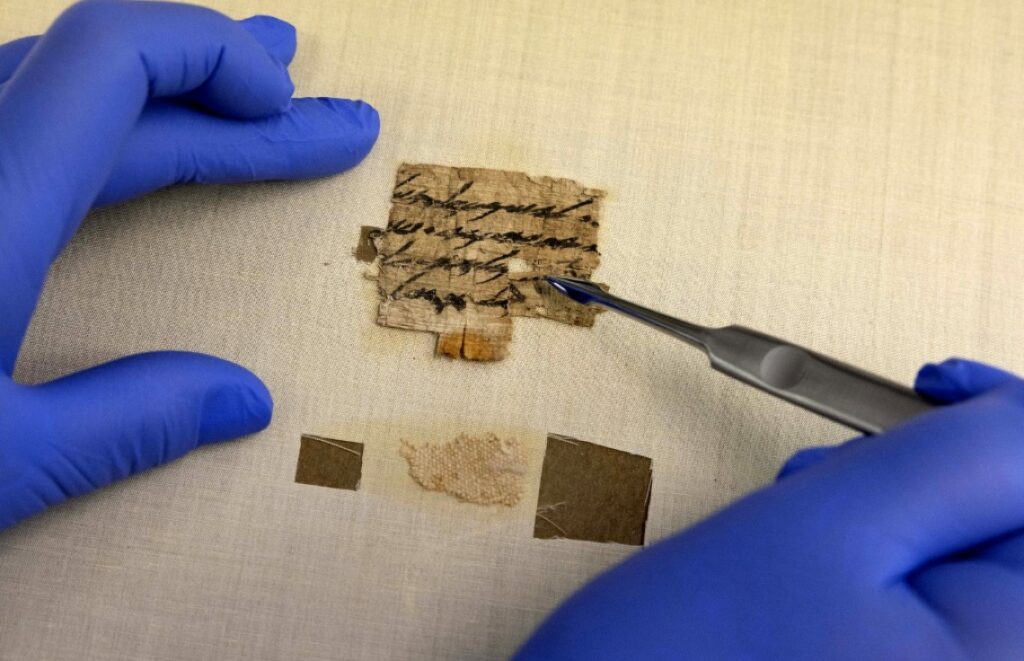An extraordinarily rare papyrus written in early Hebrew, a missive to one “Ishmael”, has been repatriated to Israel, the Israel Antiquities Authority reported on Wednesday.
The document was recovered thanks to a cooperative effort by the Antiquities Theft Prevention Unit at the IAA with biblical studies professor Shmuel Ahituv, the Ministry of Culture and Sport, and the Ministry of Jerusalem and Heritage. The document is from the First Temple period, which is the late seventh or early sixth century B.C.E.
It is one of the only three papyri ever found from the First Temple period, about 2,700 years ago. Its origin is unknown, however it most likely came from a cave in the Judean Desert. It was sold to an American woman in the 1950s, it is known.
There is a far greater number of the famed Dead Sea Scrolls, which were found in multiple caves in the Judean Desert in the 1940s and 1950s, but they date to the Second Temple period, which was centuries later, almost 2,000 years ago.
Archaeologists and ancient Hebrew experts only discovered this papyrus in 2018, following the death of Dr. Ada Yardeni, an ancient Hebrew script professor. She was working on a book on the history of Hebrew writing at the time of her death, and Prof. Shmuel Ahituv was asked to finish it. Ahituv was awarded the prestigious Israel Prize for Biblical Studies and is regarded as one of the foremost authorities on ancient Hebrew script.
To his surprise, the document included a photograph of the rare and, until then unknown, document from the First Temple period, together with Yardeni’s preliminary deciphering of the text.
The letter is made up of four unfinished lines that start with “To Ishmael send…” Overall, the wording suggests that this was a letter that had instructions for Ishmael, whoever that may have been; yet, the letters are very difficult to see, and it appears that the message was hurriedly written.
In an effort to determine where the papyrus came from, Ahituv then got in touch with the IAA’s Theft Prevention Unit.



The papyrus was given to a person in Montana by Joseph Sa’ad, the then curator of the Rockefeller Museum, and Halil Iskander Kandu, a well-known antiquities dealer from Bethlehem who many years ago sold thousands of Dead Sea Scroll fragments. Dr. Eitan Klein, the deputy head of the prevention unit, made contact with the Yardeni family and together they were able to locate the papyrus. One of them either gave her the papyrus or sold it to her.
According to the news of Haaretz, the scroll piece was framed and put in his mother’s living room in Montana. After she passed away, her son—who also happens to specialize in the field of manuscript preservation—asked an American expert on the Dead Sea Scrolls for help in deciphering the text.
The document’s owner, who requested anonymity, received an invitation to travel to Israel in 2019. He was given the opportunity to visit the Jerusalem Conservation Laboratory of the IAA’s Judean Desert Scroll Department in order to convince him to move the delicate manuscript to Israel. After the visit, the owner was convinced that these were the ideal circumstances for preserving and studying the rare document, so he signed a contract and kindly donated it to the IAA.
The Weizmann Institute in Rehovot radiometrically dated a sample to ensure the paper wasn’t a forgery and the resultant date agrees with the paleographic judgement (based on the letter forms). All agree: the material and the script are First Temple period.
Ahituv’s resarch of the papyrus will be presented Thursday at the Antiquities Authority’s First Judean Desert Conference at the Bible Lands Museum in Jerusalem.
About Papyrus “Towards the end of the First Temple period, writing was widespread,” said Dr. Joe Uziel, the director of the Antiquities Authority’s Judean Desert Scrolls Unit. “This is evident from many finds, including groups of ostraca [documents written on pottery sherds] and stamp seals with writing, that have been discovered in many ancient urban settlements, including in the royal capital of Jerusalem.”
Uziel adds hardly any documents from the First Temple period written on organic material, such as papyrus made of reeds, have survived the ages. “We have thousands of scroll fragments dating from the Second Temple period, but only three documents, including this newly found one, from the First Temple period. Each new document sheds further light on the literacy and the administration of the First Temple period.”
